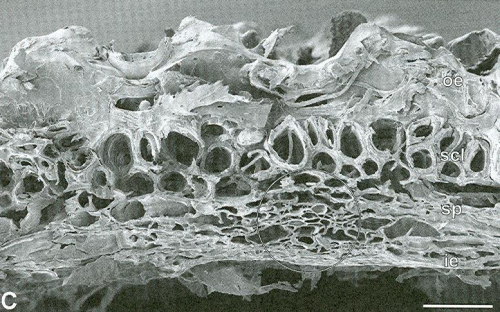
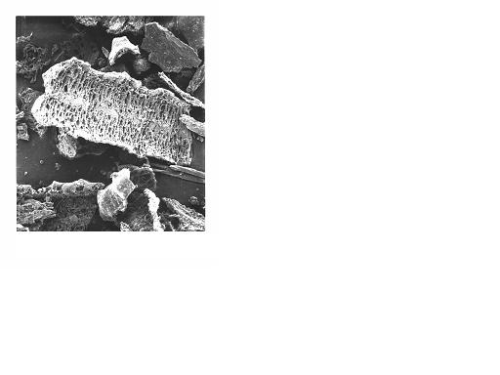
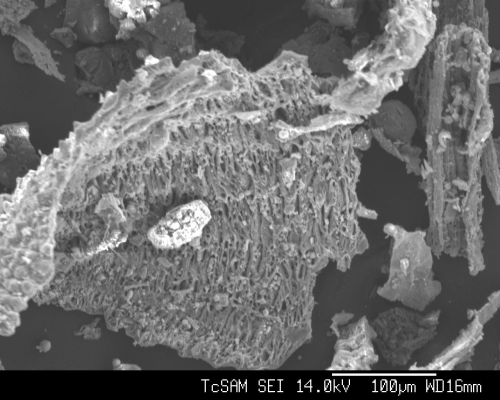
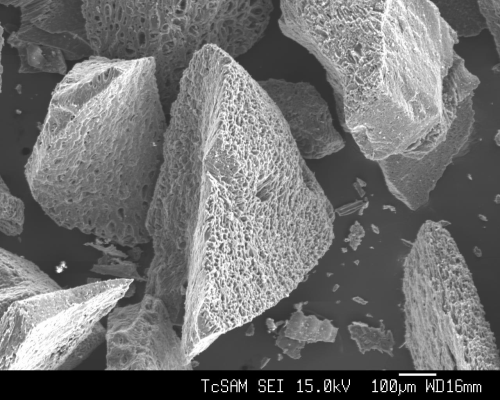
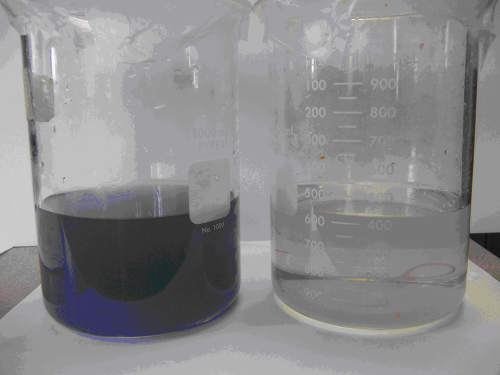
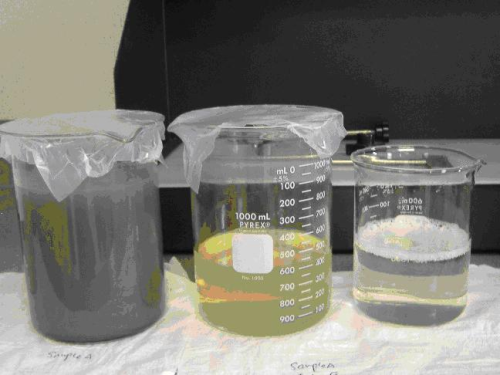
What is rice hull ash?
Rice Hull Ash (RHA) is produced duringsteam or energy generation process by combustion of rice hulls, which serve as a renewable biofuel. Rice hulls naturally have around 20% silica, and 80% carbon, and a porous structure as shown in Figure 1. After burning out of the carbon, a highly porous, amorphous silicate ash can be produced with proper combustion method and control – seeFigure 2.
There are various combustion process affecting the rice hull ash structure and chemical physical properties, such as Stoker Grate, Suspension Burning, Fluidised Bed, and Gasification. The Suspension Burning Process
generally produces more amorphous silica, less crystalline silica, and a more porous structure than other combustion processes. This article focuses on the MaxFlo RHA produced by the Suspension Burning Process. Rice hull ash can be widely used in filtration and separation, adsorption and absorption in chemical, petrochemical, refining, food, wine, beverage, pharmaceutical, biotechnology, environmental, water and wastewater treatment applications; insulation in steel industries; cement additives and/or substitute for construction uses. RHA can be also used as soil amendments and pest control. This article focuses on MaxFlo RHA for water and wastewater treatment applications.
Physical, chemical and filtration properties
RHA produced from the Suspension Burning Process is a relatively pure amorphous silicate material with a porous structure (Figure 2), low carbon content, low crystalline silica content, low bulk density, irregular particle shapes, high filtration cake permeability, and low cake compactibility. Physical, chemical, and filtration properties of MaxFlo RHA are shown in Table 1. The relatively pure silicate composition, porous structure,
irregular particle shapes, high permeability, and low cake compactibility qualify the ash as a highly efficient filter aid product in a wide areas from waste, process water or oil treatment to ultra pure liquid production.
Examples of RHA filter aids in the area of filtration and separation include:
• Cake Filtration: > 1% solid content suspensions
• Plate and frame filter press
• Automatic filter press
• Rotary drum filters
• Leaf filters
• Belt press
• Candle filters, Nutsch filters, etc.
• Polishing Filtration and Purification: low solid content systems with or without cake formation
• Sock filters
• Sand filters
• Membrane filters, etc.
Adsorption properties
Rice Hull Ash has been widely used as an efficient filter aid to assist filtration of difficult to filter solid-liquid systems such as colloids, fine, highly compactible particular solids, or hard to be deliquored materials.
Recent research on Maxflo RHA showed very good adsorption properties of RHA regarding colour, odour, COD, BOD, and iron, copper, arsenic removal in certain water and wastewater applications. Compared to activated carbon, which generally possesses physical adsorption for organic compounds due to the highly porous structure and surface area, rice hull ash material exhibit both physical adsorption for organic compounds removal and chemical adsorption (ion exchange) to removal certain irons and metals. Physical adsorption of the RHA is due to its porous structure and surface area. A comparison of activated carbon and RHA structure indicates similar microscope morphology as shown in Figure 3. Future study to enhance RHA physical adsorption includes physical or chemical treatment to increase porosity and to further open micro scale pore structure.
Rice Hull Ash water treatment case applications
As mentioned above, MaxFlo rice hull ash is an efficient filtration aid product with adsorption performance for certain organic compounds, and metals removal. Case studies of RHA in various water and wastewater
applications regarding TSS, turbidity, color, odor, COD, BOD, Oil and Grease, algae, heavy metals, and arsenic removal will be shown as follows.
Colour and odour removal from wastewater
In this example, the water to be treated was car wash water with an original turbidity of 117 NTU, and over 500 PtCo colour. After mixing with 5% MaxFlo for 10 minutes, and filtration with Whatman #2 filter paper, the turbidity of filtrate reduced to 10.7NTU, and colour was lowered to 131 PtCo. There was over 91% of turbidity and over 74% colour removal. The original water had a strong NH3 odour. The odour was greatly reduced after treatment. A picture of the water before (left) and after (right) treatment is shown in Figure 4.
COD removal from water
This example involved a wastewater stream with a COD of 485 mg O2/l, which is higher than regulated disposal limit. After filtration with addition of 2% cationic electrolyte treated rice hull ash, the COD was reduced
to 71 mg O2/g, which enabled disposal of the water stream.
COD, BOD, and oil and grease (O&G) removal
This example involved a wastewater stream containing high COD, BOD and O&G content. The water was first mixed with a rice hull ash modified by a flocculant, and went through a filtration process. The filtrate was further mixed with a cationic electrolyte treated rice hull ash for 10 minutes, and went through a filtration process again. The COD, BOD, and O&G are reduced by 60%, 61%, and 100% respectively. Pictures of treated and
untreated water sample are shown in Figure 6, where on the left is the untreated water, in the middle is the first step treated water, and on the right was the second step treated water sample.
Table 1: Chemical, physical and filtration properties of a MaxFlo RHA product
| Physical properties | ph | 6.5 - 8.0 |
| Bulk density,lb/ft3 | 13 - 18 | |
| D50, μm | 120 - 150 | |
| Filtration properties | Permeability, Darcy | 2.0 |
| Wet cake density lb/ft3 | 16 | |
| Filtrate turbidity, NTU | <10 | |
| Compactibility | Non to low | |
| Chemical properties | Amorphous silicon dioxide | 92 - 95% |
| Crystalline silica | <2% | |
| Carbon | 2 - 8% | |
| Metal oxides contaminants | <3% |
Table 2: Swimming pool water testing data
| Sample # | ph |
Turbidity NTU |
Colour PtCo | TSS mg/L | Green Algae | Total Chlorine | Ending pressure psi |
| Ideal water | 7.4 - 7.6 | - | - | - | none | 1.5 - 3 | - |
| Untreated | 6.84 | 11.3 | 173 | 24 | Extensive | 0 | - |
| Sand filter only | 6.38 | 7.52 | 129 | 16 | Extensive | 0.6 | |
| MaxFlo Precoating Filtration | 7.12 | 3.37 | 59 | 8 | none | 0 | 9 |
| % Removal with MaxFlo precoating | - | 67% | 66% | 67% | 100% | - | - |
Feature 7
Green algae removal from swimming pool water
This lab test involved filtration of swimming pool water by sand filters with a cationic coagulant-treated rice hull
ash product as the sand bed precoat. Comparison of filtration ending pressure and filtrate quality with the modified rice hull ash precoating, and with sand bed only are shown in Table 2. Results show with the modified rice hull ash precoat, colour, total suspended solids (TSS) and green algae removal efficiency of the sand filter are greatly improved. Precoating did not add too much extra operation pressure to the filter.
Heavy metals removal
This example involved a plant scale wastewater treatment operation from a chemical plant with a treated RHA
materials for heavy metal removal and fixation. After the modified RHA treatment, turbidity, TSS, copper, lead,
zinc, nickel, chromium removal were all over 95%. The cake has passed the EPA TCLP test for safe disposal, which cannot be achieved without addition of the modified RHA product. Testing results are shown in Table 3.
Table 3: RHA for heavy metal removal
Property
Untreated water
Treated water
% removal
Discharge limit
Turbidity,NTU
>100
0.06
>99.4
<0.2
TSS,ppm
100
<0.2
>99.8
<1
Copper,ppb
2000
<5
>99.75
15
Lead,ppb
100
<5
>95.0
60
Zinc,ppb
3500
<10
>99.71
250
Nickel,ppb
400
<5
>98.75
130
Chromium, ppb
1000
<100
>90.0
150
Summary
MaxFlo Rice Hull Ash produced from suspension burning process is characterised by low crystalline silica, low carbon, good filtration and both physical and chemical adsorption properties. Case applications showed good colour, odour, COD, BOD, Oil and Grease, and metals (iron, copper, lead), and arsenic removal in various water and waster water applications. Compared to other adsorbent such as powder activated carbon, the MaxFlo Rice Hull Ash has advantages such as lower cost, both physical and chemical adsorption, and better filtration performance. Adsorptive grades of MaxFlo rice hull ash with enhanced adsorption properties are under development.
Contact:
Wenping Li, Carl Berthold, Carl Kiser, Quintin Richard
Agrilectric Research Company, USA
Email: wenpingl@agrilectric.com
www.agrilectric.com
Please contact the authors for references.





